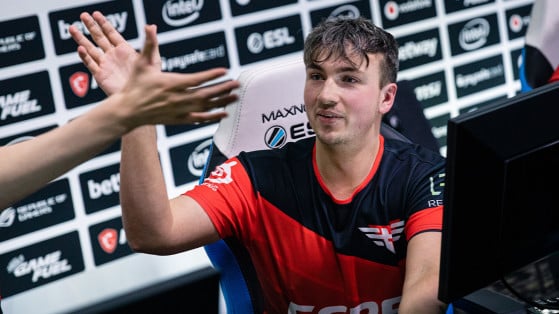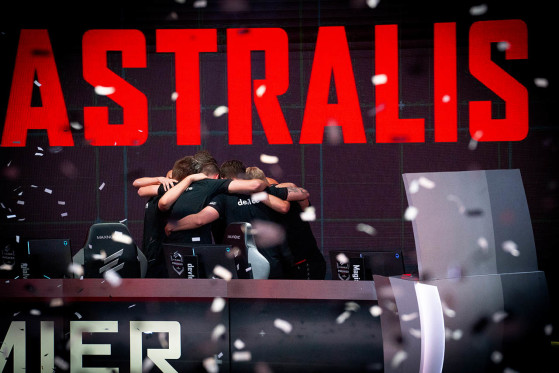Last month, on 22nd of March, Astralis announced that they had secured es3tag's signature. Despite this roster move featuring one of the biggest teams in CS:GO, it appeared to be a rather unremarkable pickup for the Danish organisation. Players jumping from team to team is hardly a revelation in the world of esports. there didn't appear to be anything notable about this transfer – except for that the fact that all five players still remain on the roster of the Danish Side, and with no sign of any of them leaving any time soon.
Es3tag’s transfer, in fact, adds a sixth player to the active roster, as a substitute. To put this situation into its proper context, the world of competitive gaming is still very much in its infancy and the question of how to actually implement substitutes into a team has yet to be adequately explored in full. In truth, this discussion has been a long time coming for all parties, and this recent acquisition by Astralis provides the prefect opportunity to dive right into the heart of this debate. Can substitutes, by which we mean actual subs, not players who are just on the roster for show or in case of injury, be useful for an esports team? Also, how should they be used within their organisation?
In certain esports titles, subs have already made their mark. A good example would be Eqo, who was forced to watch from the sidelines as his team competed in Overwatch's OWL for almost a an entire season, before spectacularly establishing himself as a star player, thanks in part to his patience and talent. Another would be the Rainbow Six Siege Pro Leauge champion, Falko, who shared his roster spot with a teammate, allowing his side to swap players between maps to adapt to the strategies of their opponents. League of Legends, the most popular competitive title in the world, has also embraced the concept of substitutions.
Yet all this may seem very idealistic. After all, there aren’t many players out there like Eqo and Falko. When you take a step back and look at the larger picture, one that encompasses a variety of mainstream esports titles, it becoming increasingly apparent that these specific cases are the exceptions to the rule, even with more and more organisations looking to take the plunge and incorporate substitutes into their ranks.
Yet the idea of bringing substitutes into a team is far from a foreign concept. On the contrary, it shares a lot of similarities with traditional sports, and much like the current iteration of esports. And if you view esports as virtual extension of traditional sports, why not learn from their experience and deny yourselves the benefits of substitutions?
What are the benefits of Substitutes?
When weighing up the pros and cons of substitutes, the balance tends to slide in their favour as much as in traditional sports as esports. There are many advantages from their inclusion, including the main argument put forward by Zonic, the coach of Astralis, which relates to player recovery.
CS:GO and its competitive open-circuit structure is perhaps the obvious representation of the mental and physical strain that continuous tournaments can inflict on esports professionals at the highest level. Take the endless travel, often across all four corners of the globe, combine it with long periods of preparation, and add in the lack of significant time off from the game, and you’ll begin to understand why players quickly see themselves succumb to burnout, which was a significant factor in Alex’s recent decision to leave Vitality.
Above all else, having a larger pool of players at their disposal allows teams to implement a rotation. This is a way of ensuring that the physical and mental state of players remains intact, so that they are able to compete at the top level throughout the year. A rotation allows teams to give a player a break, potentially during an unimportant tournament, whilst also giving another pro their chance to shine.
This quickly brings up another benefit of having more players on the roster than there are places in the team. This installs a sense of competitiveness between players on the roster, as six players are forced to fight it out for five spots on matchday. Currently, there is no set model for how to get the best out of each of your players. This system ensures that players are no longer allowed to sit idly by until the next transfer window, with the assurance that they’ll play in all matches even if their effort is severely below par during practice, or even in matches themselves. This motivation, just in itself, would be a real asset for teams.
Installing a friendly rivalry between players in the same team, if managed properly, ensures that players coming into the side will do their best to earn their place in the starting roster. In short, this guarantees that players will continue to devote themselves to the game instead of relying on their past glories to carry their profile.
The tactical diversity that a substitution system offers should also not be overlooked, as it can help teams seal decisive rounds during close matches. For coaches, having more players available quickly opens the door to two main schools of thought when making strategic decisions. The first: that by changing the starting lineup, a team can become less predictable, and therefore harder to read. The second: that a team can make adapting to their opponents easier by changing players and relying on their unique skills and attributes.
The tactical inclusion of Falko is this perfect illustration of this concept. In 2017, during Season 4 of the Rainbow Six Pro League, while preparing to face a Brazilian team known for their aggressive tendencies, Penta Sports would move Falko to the starting roster at the expense of his German contemporary. This allowed the Frenchman use gadgets to outfox the south-Americans and completely deny them of any information, taking them off of their gameplan entirely. Penta simply would not have been able to make this adjustment and employ this strategy if they did not have a player with Falko’s mastery of utility gadgets waiting in the wings.
If we dive even deeper into the benefits that substitutes can bring to a side, we begin to notice the influence that an extended roster has on player development. You’ll be hard pressed to find a single team in esports that has not been affected by the departure or sale of a player. It’s simply an unavoidable aspect of competitive gaming. So how should react teams in these circumstances? In the majority of esports titles, the normal course of action is to recruit another player from outside the team. Having substitutes that work with the team on daily basis, who are well versed on the strategy and communication used within the team, as well as a variety of other factors, allows them to quickly get to grips with the way the side plays, while an external player is forced to take his time learning the system
A quick scan of competitive gaming will reveal further examples of this being put into practice. Once again, in Rainbow Six Siege, there are two clear cases that spring to mind. While visa issues prevented Alphama from playing in the North American Pro League as a full professional, the youngster was able to benefit from his time on the bench. Once he was cleared to play in the US, Alphama was able to make a rapid impact on his team, thanks in part to his experience as a substitute. Virtue, another Rainbow Six player, provides a different experience of being a substitute. Before playing in Europe with G2 Esports, the Australian started his career as a 6th man for Fnatic, with the aim of working his way into a starting lineup that he would later become the star of.
When considering the nature of player development in esports, some teams may rely on academy teams and lower-level tournaments to bolster their ranks. This can prove reliable, even if these teams typically tend to end up as farm teams, which provide talent for the main team, rather than becoming real contenders themselves. It also allows organisations to develop players in their B team that may go on to make their impact in the main squad.
Before bringing the discussion of the benefits of subs to a close, it’s a good idea to touch on another impact they may have if substitutions become commonplace across the majority of esports . This wouldn’t be felt directly by the players, and would instead add another component to being a fan of your respective team. Discussing the merits of the composition that your coach has settled on against Astralis or Na’Vi, for example, would not only make fans realise how important a coach can be, but would also add more fuel to the discussion, as fans could debate over which players would be best suited for the task.
Tactical layers on tactical layers
While the advantages of adding substitutes to your team may seem like an attractive prospect, it remains to be seen how this model will be implemented and managed across esports, mainly due to the potential damage an inflated roster can inflict on a team. In the current landscape, players are widely unfamiliar to having to share their spot with a teammate during tournaments, which implies that adopting this scheme will take some serious getting used to for the majority of esports professionals. As for Astralis’ decision, it was reportedly the players themselves that put in this request, making a great leap in a environment where an active 6th player is far from the norm. However, are other esports pros completely ready to make this sacrifice and put their own position in jeopardy? That remains unlikely.
And what of the organisations themselves? Just like in all other professional environments, adding a new professional on the roster results in one more salary to pay at the end of the month. Having six players on the roster instead of the usual five leads to organisations paying six players, while only five can fit in one server and influence the outcome of their matches. Currently, picking up a 6th player in the current esports landscape, where most teams run at a loss, would be a luxury that is hardly a realistic proposition for many. Buying players and ensuring they can perform to the best of their abilities takes a toll on the budget, as does hiring a quality backroom staff that can take over operations, which is increasingly becoming an essential part of top-level Counter-Strike.
For a substitute to provide a return on their investment, they’ll have to be fully integrated into practice and actual competition, rather than just being there as a mascot or in case of injury. Scouting, which is deserving its own analysis, would also become more important in this prospective future. Organisations will have to fight it out for players, including: youngsters with a lot to prove, misunderstood players with a high ceiling, and grizzled veterans nearing the end of their career; players that would be comfortable with taking a lesser role and a lower paycheck than the team’s stars.
But even assuming that teams decide take on substitutes, and that orgs decide to spend more on additional salaried players, bench players are unlikely to make an instant impact. Adopting this concept further complicates a team’s pre-existing financial and ideological approach to the game, and even adds logistical problems to the mix. In order to get the best out of es3tag and to help him feel at home in their organisation, Astralis will have to treat him the same way as his teammates, by finding time for him to get a feel for playing alongside them in practice and real competition.
But there is one problem with this plan that can’t be overlooked: how can you properly acclimatise a player when Counter-Strike, like a number of other high profile esports titles (LoL, DotA 2, R6:S), is a five versus five game? Even more so since coaches aren’t currently allowed to make changes to their roster mid-game. While this would technically be possible in CS:GO and R6 when teams switch sides mid game, it would be difficult to make subs during other moments in the game without impacting the dynamic, even more so during MOBAs such as League of Legends. Finding a way to include substitutes is a challenge in itself, especially since developers have yet to figure it out themselves.
The final issue with a 6th man relates to flexibility. Though the prospect of bringing in a substitute currently seems like a luxury for most organisations, what’s to say that teams in the future won’t have substitutes for every position? Across a variety of tactically-demanding titles, there are a number of specialists that are well known for their unique attributes or roles. A player with aggressive tendencies will play an entry-fragging role for a team and will use specific guns and take positions that will get the most out of their idiosyncratic playstyles. A player who takes the role of support will do pretty much the opposite, instead relying on their gamesense and poise to help the team. In League of Legends, there’s a distinction between Carries, Junglers and Supports, while in CS, players can be split into AWPers, Lurkers, and Entry-fraggers.
Taking on an additional player to round out a 6-man roster, instead of just playing with the usual five, is to state that your substitute can replace any of their teammates at a moment’s notice, and that they know how to play all the roles in the team. At the top level, this is nigh on impossible, and poses the question of how flexible players should be in their roles. It’s possible that team will prioritise versatile players when looking to fill out their roster. As esports teams look to bring in substitutes, expect them to pick up players that can play a variety of roles, so that they can avoid recruiting a sub for every key position in the team.
Are Astralis Leading the Way?
The question of how to integrate substitute players is certainly not an easy one. It’s a hot topic that divides opinion, but Astralis may yet have the answer. Speaking about es3tag joining the team in July, the coach of the triple major winners had this to say: “We will have six players on the team, not five and a sub. Some will play more than others, but we’re focusing on long term performance and player health, and I think that everyone will play during tournaments.” He also touched on how the team would use their new addition: “everyone will contribute towards preparation, practice, and teamwork… I’m sure that we’ll continue to change things and find new and improved ways to help our players.”
After all, if it’s Astralis making this decision, how could you not believe in it? Thanks to a number of innovative structural changes brought in by Kasper Hvidt, a former Danish international goalkeeper in handball, the Danes have become a winning machine, placing them firmly into the debate over the greatest organisation in CS:GO history.
The name as Astralis has become synonymous with innovation, positioning them perfectly to tackle the question of substitutes. Although some may see it as a gamble, and others as a flawed plan, this is Astralis we’re talking about; you can guarantee that there will be an elaborate plan behind this acquisition, one that once that helps the team continue to stay one step ahead of all other organisations.
However, there will be plenty barriers, such as Counter-Strike Majors, which only allow teams to register six players and a coach, making it impossible to rotate players between matches. But who’s to say that Astralis’ innovation won’t convince Valve to have a change of heart and reform their system to accommodate an expanded roster?
Like countless other still ongoing projects in this new era of esports, we need to time to test their impact, analyse all outcomes, and draw conclusions on their effectiveness. Semantics aside, should esports be considered a form of sport? Should it become a replica of it? No one can deny the presence of strong similarities between the two. Over the years, sport has learned from its mistakes and established a incredible infrastructure around its games, so wouldn’t it make sense to learn from it as much as possible? Astralis, who seem ahead of their time, appear to be saying yes. Time will tell how this move will play out, all we can do is watch.





